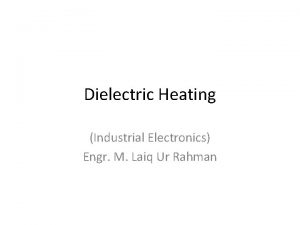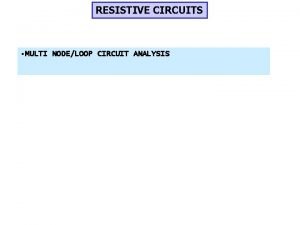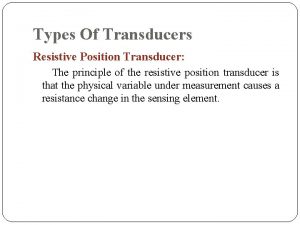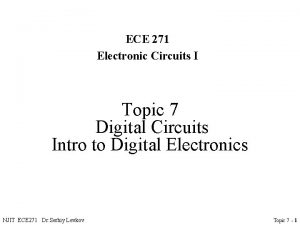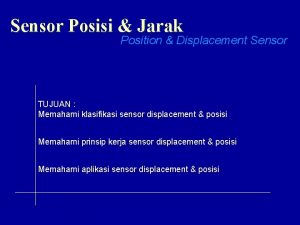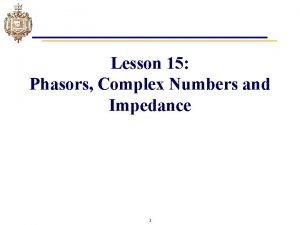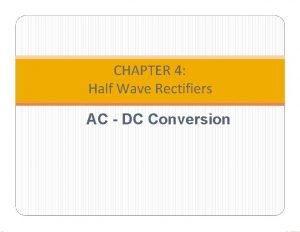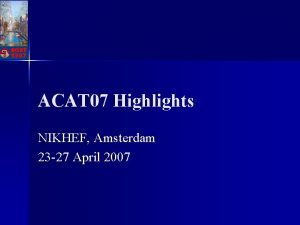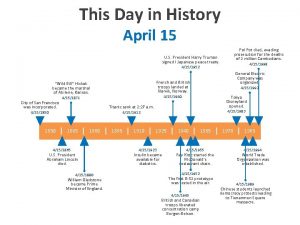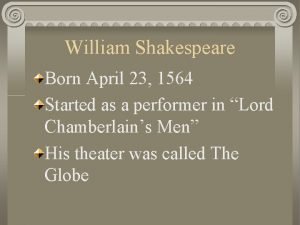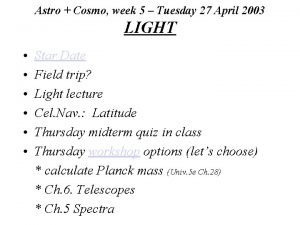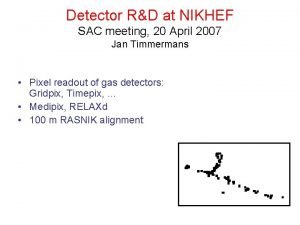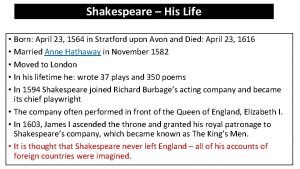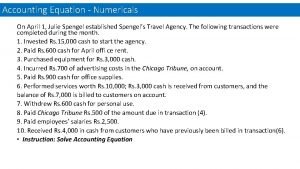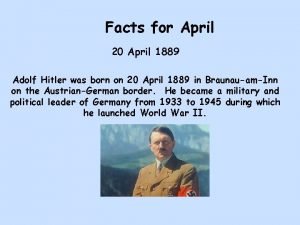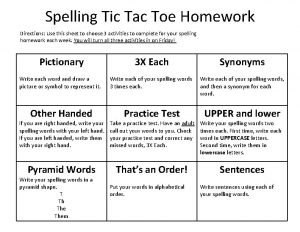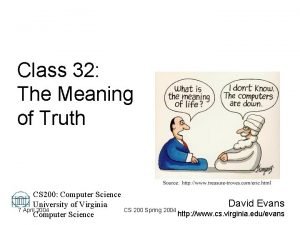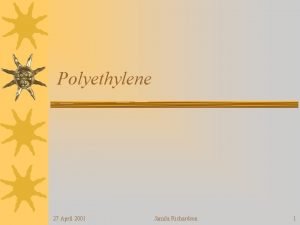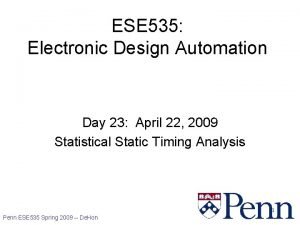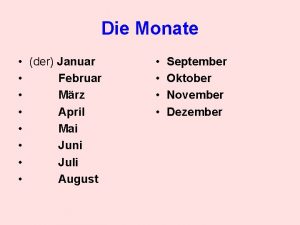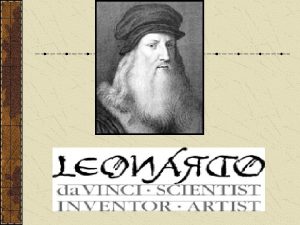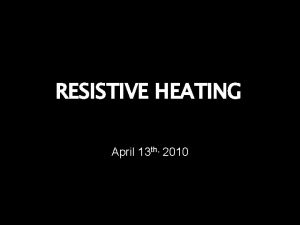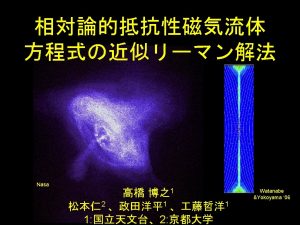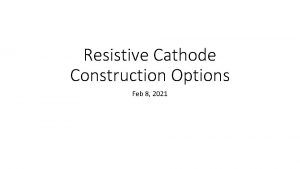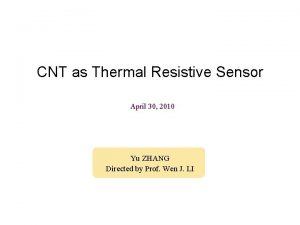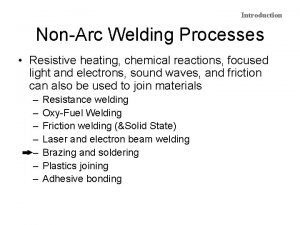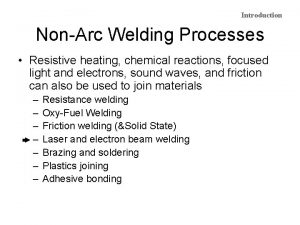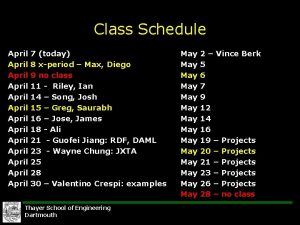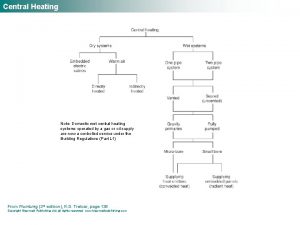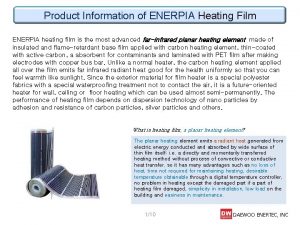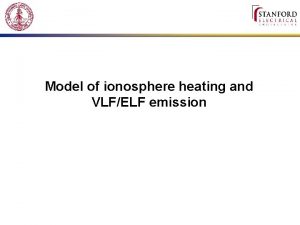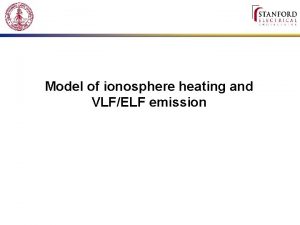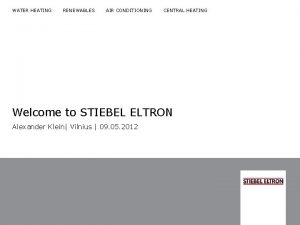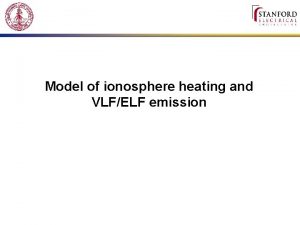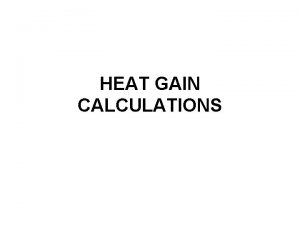RESISTIVE HEATING April 13 th 2010 RESISTIVE HEATING





















































































- Slides: 85

RESISTIVE HEATING April 13 th, 2010

RESISTIVE HEATING Mark 4 th Year Physics student at UBC, Graduated at Riverside Secondary in Port Coquitlam Basketball, Soccer, Music, and Sailing

What Do Each of these Have in Common?

What Do Each of these Have in Common? Burns Bread

What Do Each of these Have in Common?

What Do Each of these Have in Common? Creates Light

What Do Each of these Have in Common?

What Do Each of these Have in Common? Transmits Electricity

What Do Each of these Have in Common? Hot Dog…. .

What Do Each of these Have in Common? Hot Dog…. . Tastes Delicious

Resistive Heating…… � Toaster… � Light Bulb… � Power Lines… � Hot Dog… � In this presentation, I plan to explain the concept that connects each one of these four objects

Resistive Heating… � What is Resistive Heating? Who discovered Resistive Heating? What causes Resistive Heating? � A little Experiment � � � Introduction � Experimentation � Calculations � Conclusion

What is Resistive Heating? � “The process by which a current is passed through a conductor and heat is released” Wikipedia

What is Resistive Heating? � “The process by which a current is passed through a conductor and heat is released” Wikipedia � Also Known as: � Resistive Heating � Joule Heating � Ohmic Heating � Electric Heating

What is Resistive Heating? � “The process by which a current is passed through a conductor and heat is released” Wikipedia � Also Known as: � Resistive Heating � Joule Heating � Ohmic Heating � Electric Heating All names mean the same thing but we will be using this name, ‘Joule Heating’ from here on, named after its discoverer.

Who discovered Joule Heating? � First experimented with in 1841

Who discovered Joule Heating? � First experimented with in 1841 � James Prescott Joule � Hence the name: ‘Joule Heating’

Who discovered Joule Heating? � First experimented with in 1841 � James Prescott Joule � Hence � the name: ‘Joule Heating’ What did he do? � Passed a current through a wire of fixed length, � Immersed in a bath of water of fixed volume/mass � Observed the temperature in the water varried with current, length of wire, and time.

Who discovered Joule Heating? � What did he do? � Passed a current through a wire of fixed length, � Immersed in a bath of water of fixed volume/mass � Observed the temperature in the water varried with current, length of wire, and time. � He came up with the relation:

Who discovered Joule Heating? Where: Q = amount of Energy produced (in the form of heat) UNITS: joules 1 joule = kg m /s 2 I = Current UNITS: amperes R = Resistance UNITS: ohms t = Time UNITS: seconds

What Causes joule Heating? � � In a complete circuit, electrons move around the circuit. Often these electrons ‘collide’ with ions, and the electrons share kinetic energy with the ions � Ion: � � a charged atom, ie: Na. Cl+ (Salt) The kinetic energy excites the ions, and makes them vibrate. This increase in kinetic energy displays itself as heat and a temperature increase occurs.

What Causes joule Heating? � � In a complete circuit, electrons move around the circuit. Often these electrons ‘collide’ with ions, and the electrons share kinetic energy with the ions � Ion: � � � a charged atom, ie: Na. Cl+ (Salt) The kinetic energy excites the ions, and makes them vibrate. This increase in kinetic energy displays itself as heat and a temperature increase occurs. SUMMARY: Energy is transfered from the electrical power supply to the conductor and any materials with which it is in thermal contact.

What Causes joule Heating? � Show “Battery-Resistor Circuit” � What do the blue spheres represent? � What do the green spheres represent? � Why do the green and blue spheres interact? � What changes when the voltage is increased? WHY?

? ? ? � So what does this have to do with: � Burnt Toast � Light Bulbs � Power � Hot transmission lines Dogs? ? ?

? ? ? � Burnt Toast? � Inside the toaster are small wires called ‘filaments’, The elements heat up when a current is passed through them and so it cooks/burns your toast.

? ? ? � Burnt Toast? � Inside the toaster are small wires called ‘filaments’, The elements heat up when a current is passed through them and so it cooks/burns your toast. � Light Bulbs? � Like the toaster, the light bulb also has a filament. The filament is made of such a material that it can withstand extreme temperatures and glow brightly. This material is usually ‘Tungsten’ which has a melting temperature of 3880 C

? ? ? � Power Transmission Wires? � � The wires are required to transmit large amounts of electricity over long distances The amount of heat lost due to Joule Heating must be reduced as much as possible to minimize energy lost to heat � We know: V=IR

? ? ? � Power Transmission Wires? � So if we maximize V, then we can minimize I, and so minimize Q Transformers are used to step up the voltage and reduce the current, while keeping the resistance constant Vlarge = Ismall R � If ‘I’ is reduced by ½, then energy lost can be reduced by a 4!!! And so: Q = Ismall 2 x R x t �

? ? ? � Power Transmission Wires? � The power lines used to transport power large distances have VERY large voltages…. 110 k. V – 230 k. V

Experiment time! � Could you use the concepts of joule heating to cook a hot dog?

Experiment time! � Could you use the concepts of joule heating to cook a hot dog? � OF COURSE!!!. . . Why?

Introduction: � Could you use the concepts of joule heating to cook a hot dog? � Hot Dogs are delicious, and so they contain salt: � Remember: Salt = Na. Cl+ which is an ion!

Introduction: � � We will place a Hot Dog in between two electrodes and apply a voltage to cook the hot dog. We perform 3 quick experiments: � 1) one hot dog � 2) two hot dogs, connected in a parallel circuit � 3) two hot dogs, connected in a series circuit

Introduction: � We will be using “Schneiders All Beef Wieners” � 110 calories, 9 g fat, 4 g protein, and 380 mg SODIUM “Taste the difference quality makes!”

Experimentation: � Lets get started: first: cook one hot dog at a time. � We will be timing the procedure, from the moment the voltage is applied, till roughly when the meat stops cooking.

Time Trial 1 Current Trial 2 Current Avg. Resistance 0 1. 5 80 30 1. 94 2. 03 1. 985 60. 4534005 40 2. 27 2. 57 2. 42 49. 58677686 50 2. 62 3. 09 2. 855 42. 03152364 60 3. 04 3. 3 3. 17 37. 85488959 70 3. 3 3. 45 3. 375 35. 55555556 80 3. 41 3. 36 3. 385 35. 45051699 90 3. 32 3. 18 3. 25 36. 92307692 100 3. 04 2. 98 3. 01 39. 86710963 110 2. 89 2. 87 2. 88 41. 66666667 120 2. 8 2. 77 2. 785 43. 08797127 130 2. 68 2. 66 2. 67 44. 94382022 140 2. 6 2. 57 2. 585 46. 42166344 145 2. 56 2. 52 2. 54 47. 24409449 150 2. 51 2. 47 2. 49 48. 19277108 155 2. 46 2. 44 2. 45 48. 97959184 160 2. 41 49. 79253112 165 2. 33 2. 37 2. 35 51. 06382979 170 2. 27 2. 32 2. 295 52. 2875817 175 2. 18 2. 27 2. 225 53. 93258427 180 2. 05 2. 21 2. 13 56. 33802817 185 1. 95 2. 13 2. 04 58. 82352941 190 1. 8 2. 05 1. 925 62. 33766234 195 0. 9 1. 93 1. 415 84. 80565371 200 0. 17 1. 67 0. 92 130. 4347826 205 0. 11 1. 02 0. 565 212. 3893805 210 0. 09 0. 2 0. 145 827. 5862069 215 0. 08 0. 13 0. 105 1142. 857143 220 0. 08 0. 11 0. 095 1263. 157895 225 0. 07 0. 1 0. 085 1411. 764706 230 0. 07 0. 09 0. 08 1500 235 0. 07 0. 08 0. 075 1600

Time Trial 1 Current Trial 2 Current Avg. Resistance 0 1. 5 80 30 1. 94 2. 03 1. 985 60. 4534005 40 2. 27 2. 57 2. 42 49. 58677686 50 2. 62 3. 09 2. 855 42. 03152364 60 3. 04 3. 3 3. 17 37. 85488959 70 3. 3 3. 45 3. 375 35. 55555556 80 3. 41 3. 36 3. 385 35. 45051699 90 3. 32 3. 18 3. 25 36. 92307692 100 3. 04 2. 98 3. 01 39. 86710963 110 2. 89 2. 87 2. 88 41. 66666667 120 2. 8 2. 77 2. 785 43. 08797127 130 2. 68 2. 66 2. 67 44. 94382022 140 2. 6 2. 57 2. 585 46. 42166344 145 2. 56 2. 52 2. 54 47. 24409449 150 2. 51 2. 47 2. 49 48. 19277108 155 2. 46 2. 44 2. 45 48. 97959184 160 2. 41 49. 79253112 165 2. 33 2. 37 2. 35 51. 06382979 170 2. 27 2. 32 2. 295 52. 2875817 175 2. 18 2. 27 2. 225 53. 93258427 180 2. 05 2. 21 2. 13 56. 33802817 185 1. 95 2. 13 2. 04 58. 82352941 190 1. 8 2. 05 1. 925 62. 33766234 195 0. 9 1. 93 1. 415 84. 80565371 200 0. 17 1. 67 0. 92 130. 4347826 205 0. 11 1. 02 0. 565 212. 3893805 210 0. 09 0. 2 0. 145 827. 5862069 215 0. 08 0. 13 0. 105 1142. 857143 220 0. 08 0. 11 0. 095 1263. 157895 225 0. 07 0. 1 0. 085 1411. 764706 230 0. 07 0. 09 0. 08 1500 235 0. 07 0. 08 0. 075 1600


Experimentation: The meat stops cooking because the connection at the electrodes gets burned out! The moisture in the weiner contains the Ions, Na. Cl, and when the moisture boils and evapourates, the hotdog stops cooking


� V=I R, thus using only the measured current and the known voltage, we can find the resistance Iave = 2. 505 m. Amps, 0. 002505 Amps � V = 120 Volts � V/I = 120 V/0. 002505 Amps = 47904 Ohms � = 47. 9 k. Ohms Thus: The average resistance of a hotdog is ~50 k. Ohms.

Experimentation: For one wiener

� The average resistance of a hot dog is 50 k. Ohms � What does this number depend on?

� The average resistance of a hot dog is 50 k. Ohms � What does this number depend on? � Size of hotdog � Moisture content � Temperature � Fat content (other brands, varieties) � Meat type (Chicken, Beef, Turkey…)

Experimentation: � Parallel Circuits: � Total resistance is calculated:

Experimentation: � Parallel Circuits: � Total resistance is calculated:

Experimentation: � Parallel Circuits: � Total Current is calculated:

Experimentation: � Parallel Circuits: � Total Current is calculated: � This is a different current than when cooking only one weiner. �Does this make sense? ? ? Ione weiner = 2. 505 m. Amps �Itwo weiners, parallel = 4. 8 m. Amps

Experimentation: � Parallel Circuits: �Does this make sense? ? ? Ione weiner = 0. 002505 Amps We know by the current law for parallel circuits that: Itotal = I 1 + I 2 So really: each hot dog is receiving the same current as it was before (when there was only one weiner cooking)

Experimentation: � Parallel Circuits: Itotal = I 1 + I 2 Thus: the current law justifies that the cooking time is the same as the previous experiment…. But what happens when the hotdogs are connected in series?

Experimentation: � Series Circuits: � Total resistance is calculated:

Experimentation: � Series Circuits: � Total resistance is calculated:

Experimentation: � Series Circuits: � Total current is calculated:

Experimentation: � Series Circuits: Thus: the resistance law for series circuits justifies that the cooking time is at least double what it was in the previous experiment…. Why more than double? ?

Experimentation: � Series Circuits: Thus: the resistance law for series circuits justifies that the cooking time is at least double what it was in the previous experiment…. Remember Joule’s equation for heat:

Experimentation: � Series Circuits: Remember Joule’s equation for heat: If we plug in the new Itotal:

Experimentation: � Series Circuits: Which is the same as: So the heat absorbed is actually ¼ the amount of heat as in the first case, so it will take ~4 times as long to cook the hot dog.

Experimentation: Results: � We Cooked hot dogs: three times: � One at a time � Two in parallel � Two in series � We achieved 2 different results: � One at a time ~3 min, 15 sec to cook � Two in parallel: ~3 min, 15 sec to cook � Two in series: ~13 mins to cook

Joule Heating: Summary � The concept of joule heating is used often: � In everyday kitchen appliances, Toaster, Iron, Electric Coffee Maker… � The same idea is used to Transport electricity, and minimize loss by maximizing voltage �Also can be used to cook hotdogs! But only in parallel circuitry, as series is a waste of time!

GROUP EXERCISE:

GROUP EXERCISE: � How much $$$ did it cost us to cook one hot dog? � ASSUME: Voltage used: 120 V Average current: 0. 002505 Amps Time to cook: 3 minutes, 15 seconds Average cost of electricity in BC: $0. 06724 / k. Wh

GROUP EXERCISE: � ASSUME: Voltage used: 120 V Average current: 0. 002505 Amps Time to cook: 3 minutes, 15 seconds Average cost of electricity in BC: $0. 06724 / k. Wh 1 Watt = 1 Volt x 1 Amp

GROUP EXERCISE: � ASSUME: Voltage used: 120 V Average current: 0. 002505 Amps Time to cook: 3 minutes, 15 seconds Average cost of electricity in BC: $0. 06724 / k. Wh 1 Watt = 1 Volt x 1 Amp 1 kilo-Watt-hour = the amount of energy in kilo Watts consumed per hour

GROUP EXERCISE: � ASSUME: Voltage used: 120 V Average current: 0. 002505 Amps Time to cook: 3 minutes, 15 seconds Average cost of electricity in BC: $0. 06724 / k. Wh 1 Watt = 1 Volt x 1 Amp 1 kilo-Watt-hour = the amount of energy in kilo Watts consumed per hour 3 minutes, 15 seconds = 3. 25 minutes / 60 minutes = 0. 0542 Hours

GROUP EXERCISE: � ASSUME: Voltage used: 120 V Average current: 0. 002505 Amps Time to cook: 3 minutes, 15 seconds Average cost of electricity in BC: $0. 06724 / k. Wh 1 Watt = 1 Volt x 1 Amp 1 kilo-Watt-hour = the amount of energy in kilo Watts consumed per hour 3. 25 minutes / 60 minutes = 0. 0542 Hours TOTAL COST = Voltage x Current x Time x Cost per hour / 1000

GROUP EXERCISE: Voltage used: 120 V Average current: 0. 002505 Amps Time to cook: 3 minutes, 15 seconds Average cost of electricity in BC: $0. 06724 / k. Wh 1 Watt = 1 Volt x 1 Amp 1 kilo-Watt-hour = the amount of energy in kilo Watts consumed per hour 3. 25 minutes / 60 minutes = 0. 0542 Hours TOTAL COST = Voltage x Current x Time x Cost per hour / 1000 = 120 V x 0. 002505 Amps x 0. 0542 hours x $0. 06724 / 1000

GROUP EXERCISE: Voltage used: 120 V Average current: 0. 002505 Amps Time to cook: 3 minutes, 15 seconds Average cost of electricity in BC: $0. 06724 / k. Wh 1 Watt = 1 Volt x 1 Amp 1 kilo-Watt-hour = the amount of energy in kilo Watts consumed per hour 3. 25 minutes / 60 minutes = 0. 0542 Hours TOTAL COST = Voltage x Current x Time x Cost per hour / 1000 = 120 V x 0. 002505 Amps x 0. 0542 hours x $0. 06724 / 1000 =$0. 000001096 or 0. 0001096 cents…… DIRT CHEAP

GROUP EXERCISE: =$0. 000001096 or 0. 0001096 cents…… DIRT CHEAP Because of BC’s abundant hydroelectricity generation. Ontario’s power costs are double ours, and california’s are more than TRIPPLE!

What determines Resistance? � We found that the resistance of the hot dog is ~50 k. Ohms Why? What factors contribute to the resistance?

What determines Resistance? � We found that the resistance of the hot dog is ~50 k. Ohms Why? What factors contribute to the resistance? -Cross sectional area -Length -Density -Ionic Content

What determines Resistance? � What would happen if the hot dog were a different shape? Ph. ET simulation #2

What determines Resistance? � What would happen if the hot dog were a different shape? � What would be a better conductor? A hot dog or a copper wire? Why?

What determines Resistance? � What would happen if the hot dog were a different shape? � What would be a better conductor? A hot dog or a copper wire? Why? The Wire: It has more free ions, and so conducts better

What determines Resistance? � What would conduct better? � A hot dog, or a LED (Light Emitting Diode)

What determines Resistance? � What would conduct better? �A � hot dog or an LED? How can we test this? � If we plug both the hot dog and the LED into the same circuit, the current should take the path of least resistance

What determines Resistance? � What would conduct better? �A � hot dog or an LED? How can we test this? � If we plug both the hot dog and the LED into the same circuit, the current should take the path of least resistance TIME TO TEST THIS:

L. E. D in Hotdog � Place 1 LED in hotdog, electrodes ~2 mm apart.

L. E. D in Hotdog � Place 1 LED in hotdog, electrodes ~2 mm apart.

L. E. D in Hotdog � Place 1 LED in hotdog, electrodes ~2 mm apart. � Move LED electrodes to ~3 cm apart. � Will anything be different?

L. E. D in Hotdog � Move LED electrodes to ~3 cm apart.

L. E. D in Hotdog electrodes are ~70 mm apart, hot dog is ~50 k. Ohms of resistance, 0. 002505 Amps Current, 120 Volts. � When LED electrodes are 2 mm apart: � 2 mm/70 mm = 0. 0286 � 0. 0286 x 120 V = 3. 44 V � LED’s are usually rated at 5 V, so anything wider than ……. . WHAT ELECTRODE DISTANCE WILL DAMAGE THE LED?

L. E. D in Hotdog electrodes are ~70 mm apart, hot dog is ~50 k. Ohms of resistance, 0. 002505 Amps Current, 120 Volts. � When LED electrodes are 2 mm apart: � 2 mm/70 mm = 0. 0286 � 0. 0286 x 120 V = 3. 44 V � LED’s are usually rated at 5 V, so anything wider than a 2. 917 mm electrode seperation will damage the LED. 5. 0 V/120 V x 70 mm = 2. 917 mm

Joule Heating: SUMMARY: Joule heating is the process that does basic things like: - cook toast, - heats an electric kettle - controls loss of long power transmissions - lights lightbulbs - COOKS HOTDOGS!

Joule Heating: SUMMARY: Joule heating is the process that does basic things like: - COOKS HOTDOGS! It works by exciting the charged molecules inside of a resistor and increasing their kinetic energy. This energy is released in the form of heat.

 Difference between induction heating and dielectric heating
Difference between induction heating and dielectric heating Isokinetic exercise definition
Isokinetic exercise definition Resistive index
Resistive index Pure resistive circuit
Pure resistive circuit Nmos inverter
Nmos inverter Resistive circuit analysis
Resistive circuit analysis Resistive soil moisture sensor working principle
Resistive soil moisture sensor working principle Resistive switching
Resistive switching Resistive displacement transducer
Resistive displacement transducer Nmos inverter with depletion load
Nmos inverter with depletion load Resistive displacement sensor
Resistive displacement sensor Complex impedence
Complex impedence Fourier series of half wave rectifier
Fourier series of half wave rectifier Leonardo da vinci was born on 15 april 1452 near
Leonardo da vinci was born on 15 april 1452 near Amsterdam 27 april
Amsterdam 27 april April 23 1564
April 23 1564 9/11 sonnet
9/11 sonnet April school activities
April school activities This day in history april 15
This day in history april 15 International day april 4
International day april 4 April decker
April decker April rain song
April rain song 3 april 2008
3 april 2008 Adolf hitler kindheit
Adolf hitler kindheit April 23 1564
April 23 1564 April bjornsen
April bjornsen April ericsson
April ericsson Mars april mai
Mars april mai 27 april 2003
27 april 2003 Play in a day
Play in a day Astronomy picture of the day 17 april 2001
Astronomy picture of the day 17 april 2001 20 april
20 april April 23 1564
April 23 1564 Thurs norse mythology
Thurs norse mythology April kindergarten newsletter
April kindergarten newsletter April 2006 calendar
April 2006 calendar The morning night april
The morning night april Reformdjp/quiz/kuis-mini-reformasi-perpajakan-mei-2022
Reformdjp/quiz/kuis-mini-reformasi-perpajakan-mei-2022 11. april
11. april January february march season
January february march season 23rd april 1616
23rd april 1616 April 23 1564
April 23 1564 26 april 1564
26 april 1564 Wetter paris september
Wetter paris september Apod nasa gov calendar 1982
Apod nasa gov calendar 1982 11 april 2000
11 april 2000 Cern april fools proposal for space
Cern april fools proposal for space Falske computer timeshare company
Falske computer timeshare company Vitaj april
Vitaj april 1889 april 20
1889 april 20 30 tage hat september april juni und november
30 tage hat september april juni und november April rustianto
April rustianto Integrigation
Integrigation When in april the sweet showers fall
When in april the sweet showers fall April fleming
April fleming My dog fred
My dog fred May june
May june 2003 april 20
2003 april 20 April raintree summary
April raintree summary April 4
April 4 How to read p
How to read p Spelling tic tac toe homework
Spelling tic tac toe homework Tbss tornado
Tbss tornado Calendar april 2009
Calendar april 2009 April art project
April art project Prakruthi kashyap
Prakruthi kashyap April ford incentives
April ford incentives April savoy allstate
April savoy allstate Meaning
Meaning 24 april 2007
24 april 2007 27 april 2001
27 april 2001 22 april is celebrated as
22 april is celebrated as 4 april christian
4 april christian 535 days before 23 april
535 days before 23 april Januar febuar
Januar febuar Leonardo de vinci was born on april 15
Leonardo de vinci was born on april 15 April 28 day of mourning
April 28 day of mourning Welcome to our class
Welcome to our class 30 days has september
30 days has september Why is april a busy month for birds
Why is april a busy month for birds April 6 1992
April 6 1992 Pada tanggal 1 april 2011 cv seneng makmur
Pada tanggal 1 april 2011 cv seneng makmur April 15 1452
April 15 1452 April safety topics
April safety topics Rosalind franklin photo 51
Rosalind franklin photo 51 April reprogle
April reprogle
